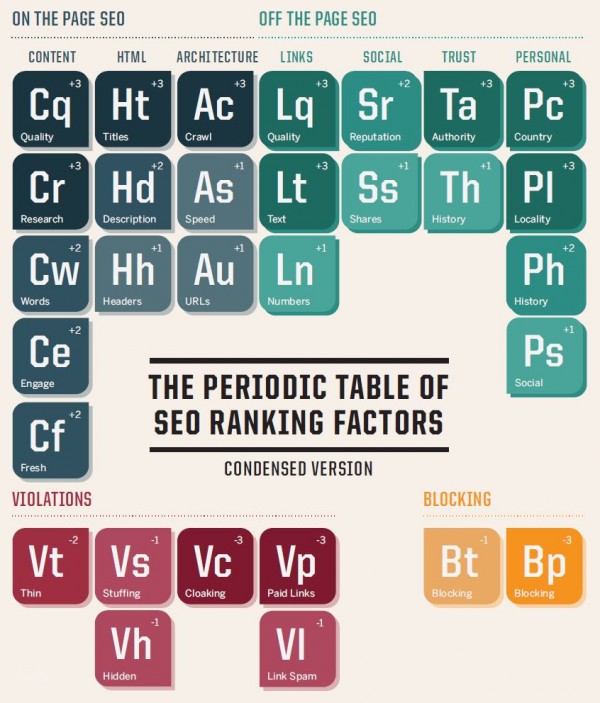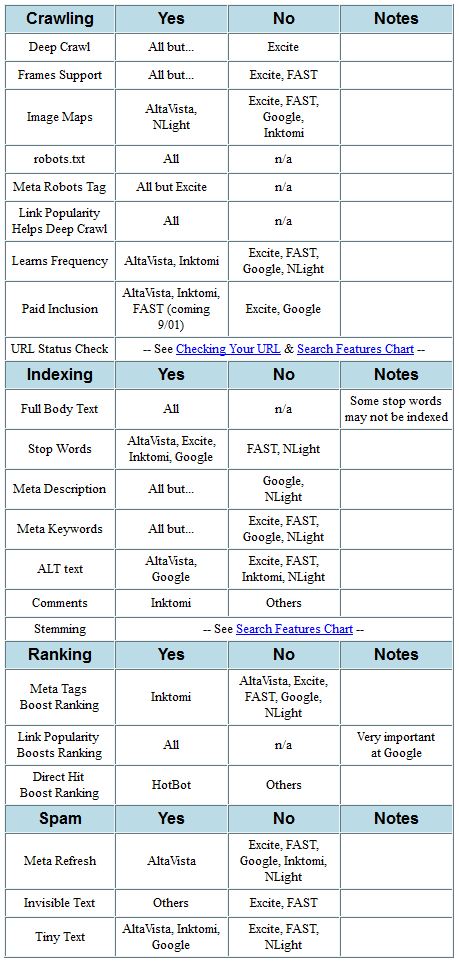Introducing: The Periodic Table Of SEO Ranking Factors
SEO — search engine optimization — is one of the most important marketing activities available to companies and publishers, but it’s too often considered some murky “dark art” or a sinful practice that should be avoided. It’s not. To help clear away some of the mystery and fear for those new to SEO, and provide […]
SEO — search engine optimization — is one of the most important marketing activities available to companies and publishers, but it’s too often considered some murky “dark art” or a sinful practice that should be avoided. It’s not. To help clear away some of the mystery and fear for those new to SEO, and provide a “reset” for those who are experienced, we’ve created “The Periodic Table Of SEO Ranking Factors.”
Clicking on the image above will take you to where we’ve permanently housed the table, along with information on how to download it for yourself. We’ve also created a new Search Engine Land Guide To SEO, based on the table and explaining what it means in more depth.
As for this introduction to the table that you’re now reading, it’s meant to explain more about the “why have a table” rather than the “what does it the table mean.”
SEO: It’s A Good Thing!
As a reminder, SEO is not a crime, a harmful act nor something that only “bad” people do, despite what you may have seen on The Good Wife. It is, in fact, a helpful activity that even the search engines, including Google, recommend.
If you want to understand more about some of the myths of SEO being “bad,” I’d recommend the further reading below. Seriously, take some time to educate yourself:
SEO’s Fundamental Factors
SEO can be confusing to both new people and experienced folks alike. For new people, it can seem like rocket science, because you might get overwhelmed with all the details and miss the relatively easy general principles. For experienced people, chasing down which particular hot new SEO “tree” to climb can blind you to the overall forest that you should be considering.
The Periodic Table Of SEO is designed to visually present the major factors, the biggest and most important things that can help you in gaining traffic from search engines. It’s focused on traffic from web search results, though down the line, we might produce similar ones for more focused search engines such as video or local. By the way, the Local Search Ranking Factors survey from David Mihm has just been updated.
There are the “On The Page” factors, the things that a publisher can control directly. “Off The Page” factors, which are things you can influence indirectly about how others can help, or harm, your chances of search engine visibility. “Violations” are the things you should avoid, sometimes common mistakes that developers or others might not even realize shouldn’t be done. And “Blocked” covers a new class of not-violations but still things that can be harmful.
Focus On Most Important Factors
Within each of these major groups are individual factors. There could be many more individual factors than we show. However, we’ve made a deliberate decision to show only those we think are most important, most consistently seen used by search engines, or verified by SEO data or commonly accepted and easily implementable.
For example, in HTML factors, we recommend paying attention to:
- Title Tags
- Description Tags
- Header Tags
We don’t try to get into whether a word you hope to be found for comes first or last in the HTML title tag. Or whether an H1 header tag carries more weight than an H2 header tag. We don’t suggest that you need to use bold text.
We avoid all that, because we feel it goes too much into unnecessary and possibly confusing depth for many people. Instead, if you know that your pages should have good, unique titles, that they should have structure that can be reflected by header tags, and that you should use the easily implemented description tag, you’ve probably covered 90% of the most important HTML-related factors.
In addition, some of the factors we list are more general goals to reach rather than specific factors that can be implemented. For example, our social factors include attaining a good social reputations and good social shares. A good social reputation on Facebook? Or Twitter? And social shares on both, or only one — and what about Google +1?
All of the above. Rather than getting lost on if Facebook or Twitter is better, or has more SEO juice, we want you to understand that social activity is increasingly having an influence on search rankings. So you want a good social reputation in a variety of networks. You want to be shared on a variety of networks. Those are among the most important general social goals you can go after.
An Overview Teaching Guide
If you want a deep-dive into those types of specifics, SEOmoz does a biannual survey of search engine ranking factors you should certainly read (it’s due to be updated very shortly). Our ranking factors table isn’t a replacement for that or others. Instead, we view it as a complementary guide.
In particular, I personally hope that it’s the type of thing that anyone versed in SEO can use to help someone else get up to speed on the fundamental building blocks. Have you done Cr, research into keywords? Here are some tools to help. Or that As — site speed — is important factor.
The factors are weighted on a scale of one to three, with three being deemed more important, though anything listed is deemed a fundamental. Not everyone may agree with how we’ve scaled things, but it’s a start. And everything’s relative. No single factor guarantees success, but having several of them increases the odds.
Blast From The Past
From a nostalgia perspective, I started writing about SEO over 15 years ago, with my first article going up in April 1996. It had an SEO ranking factor chart as part of it, which looked like this:
This grew rapidly by the following year, to cover issues such as whether frames posed a barrier to being crawled. Here’s only part of the successor to my original chart, from November 1997:
Here’s a version from July 2001, which makes me smile as I remember that for a short period of time, how a site performed in Direct Hit’s clickthrough measurements could have a ranking impact:
I stopped maintaining this type of chart in 2003. In part, it was because a lot of the major “signals” or factors used by the different search engines were becoming more and more the same. The world also became fixated just on Google, which in term was largely driven by rewarding those with the best links.
I found it nice to come back years later and think afresh about how I’d organize the factors. It was fun to put back on my graphics reporter hat, which I haven’t worn since I used to do infographics work in my pre-search engine life.
Of course, I’m not an artist. Turning the periodic table into a great visual concept was the work of the good folks over at Column Five Media, which has a wonderful portfolio of infographics. It was a pleasure to work with them. Special thanks to Jason Lankow and Josh Ritchie.
Also thanks to our technical director Michelle Robbins, who did a ton of last minute work to get the chart ready to go online here.
If you enjoy the chart, find it useful — please, reward our Cq with some Ln, Lt and especially Lq. Also appreciated is any Ss. Give us some Ce, too. Comments are more than welcome. And the best with your SEO!
Related Posts
Contributing authors are invited to create content for Search Engine Land and are chosen for their expertise and contribution to the search community. Our contributors work under the oversight of the editorial staff and contributions are checked for quality and relevance to our readers. The opinions they express are their own.
Related stories
New on Search Engine Land




